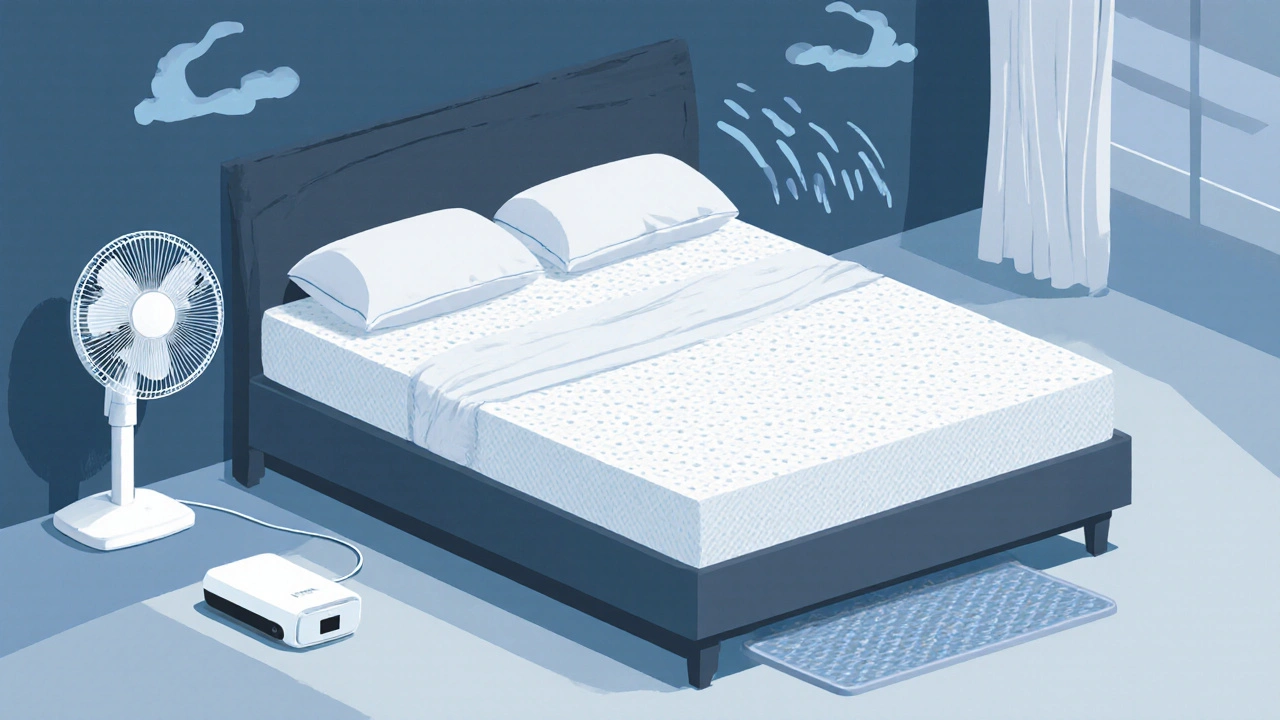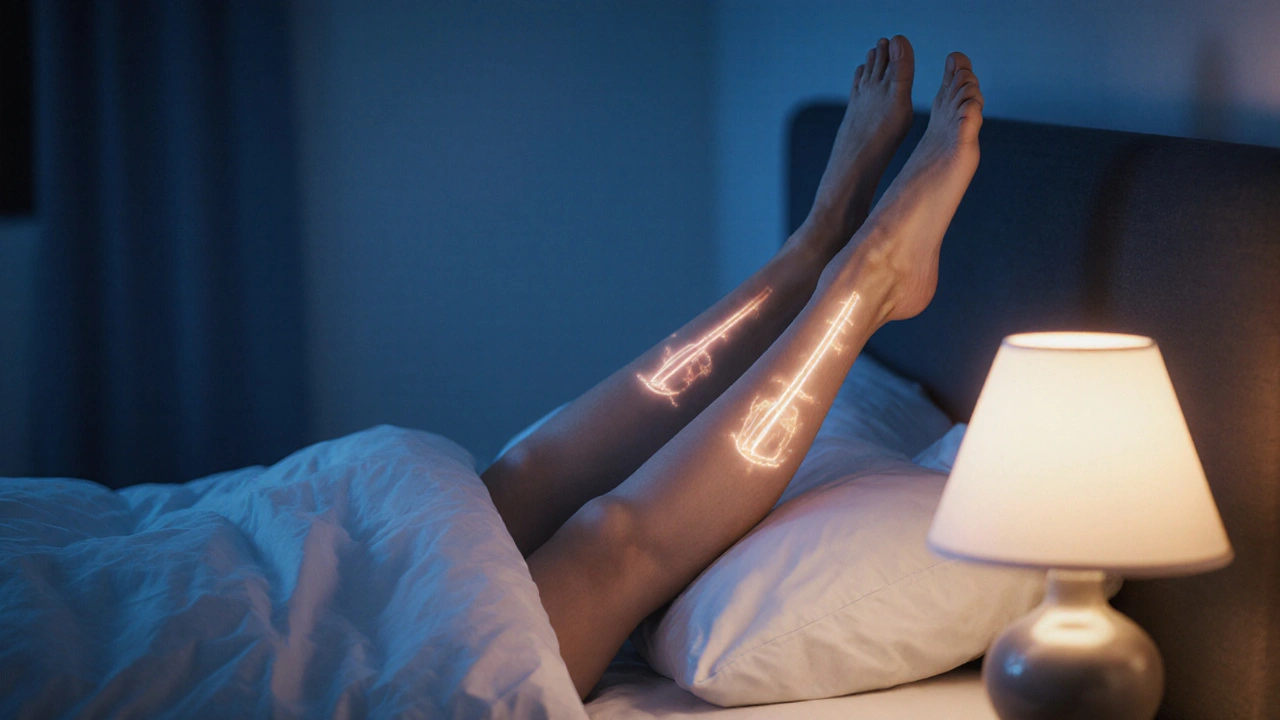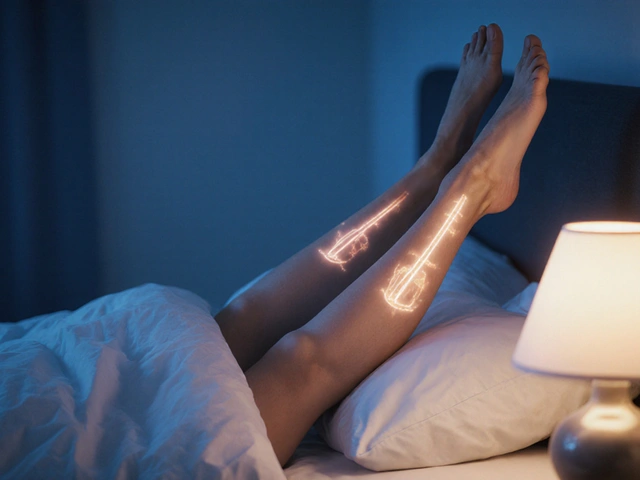RLS Sleep Environment Optimizer
Your personalized RLS-friendly sleep environment recommendations will appear here.
If you toss and turn because your legs feel like they’re doing a midnight dance, you’re not alone. Restless Leg Syndrome (RLS) can turn bedtime into a frustrating battle, but the right sleep environment can make a huge difference. Below you’ll find a practical, no‑nonsense plan to turn your bedroom into a calm zone that eases those jittery legs and lets you drift off easily.
What Is Restless Leg Syndrome?
Restless Leg Syndrome is a neurological condition that creates an irresistible urge to move the legs, especially when you’re trying to rest. It often shows up as tingling, crawling, or burning sensations that worsen in the evening and improve with movement. While the exact cause is still debated, low iron levels, dopamine imbalances, and genetics play major roles. Understanding the triggers helps you tailor a bedroom that reduces the symptoms rather than amplifies them.
Core Principles of an RLS‑Friendly Sleep Space
- Minimize leg‑stimulating pressure points.
- Keep the room cool and well‑ventilated.
- Eliminate visual and auditory distractions.
- Introduce gentle, soothing vibrations or sounds.
- Support your legs with the right after‑day care (stretching, supplements, compression).
Follow each principle and you’ll notice fewer night‑time leg jerks.
Optimize Your Bed: Mattress, Pillow, and Bedding
What you lie on matters more than you think. A firm yet cushioned surface reduces pressure on the calves and thighs, which can aggravate RLS.
Mattress is the foundation of your sleep environment, influencing spinal alignment and pressure distribution. For RLS, look for medium‑firm models with good motion isolation so you don’t feel every shift.
| Type | Firmness | Motion Isolation | Pressure Relief | Best For |
|---|---|---|---|---|
| Memory Foam | Medium‑firm | Excellent | High | Side sleepers, low motion partners |
| Innerspring | Firm | Poor | Moderate | Back sleepers, budget‑focused |
| Hybrid | Medium‑firm | Good | High | Combination sleepers, those wanting bounce |
| Latex | Medium | Good | Very High | Allergy‑sensitive, eco‑conscious |
Pair your mattress with a supportive pillow that keeps the neck neutral and reduces overall body tension.. A pillow with adjustable fill lets you fine‑tune loft, which can help keep the spine aligned and avoid extra leg strain.

Control Temperature and Lighting
Cool air soothes restless muscles, while bright lights can reset your internal clock and make RLS flare.
Room temperature should stay between 60‑67°F (15‑19°C) for optimal sleep quality. Use a programmable thermostat or a simple fan. If you live in a hot climate, a breathable cotton sheet set helps wick away sweat, preventing limb overheating.
When it comes to lighting, opt for dim, warm‑hued bulbs or smart lights that gradually dim to mimic sunset. Blue‑light blocking glasses an hour before bed can also reduce nighttime leg sensations.
Sound and Gentle Vibration
Background noise can mask the subtle sensations that trigger leg movement. A steady hum often works better than total silence.
White noise machine produces consistent sound frequencies that calm the nervous system. Choose a model with multiple sound profiles (rain, wind, fan) and a timer that fades out after you’ve fallen asleep.
If you’re open to wearables, a low‑level vibrating pad placed under the mattress can provide continuous gentle stimulation, subtly reducing the urge to move.
Reduce Leg Discomfort Before Bed
Pre‑sleep habits directly influence how often RLS strikes during the night.
- Stretching routine: Perform 5‑minute calf‑and‑hamstring stretches 30minutes before bedtime. This improves circulation and eases muscle tightness.
- Compression stockings: Wearing light‑pressure stockings (15‑20mmHg) can boost venous return, cutting down on cramping.
- Magnesium supplement: Magnesium glycinate at 200‑400mg nightly supports nerve function. Choose a reputable brand that’s free from added iron.
- Iron check: Low ferritin is linked to RLS. If you haven’t had a blood test in the past year, ask your doctor to screen for iron deficiency.
These steps act like a “pre‑flight checklist” for your legs, ensuring they’re relaxed before you hit the covers.
Sleep Hygiene and Lifestyle Tweaks
Good habits set the stage for a restful night.
Sleep hygiene refers to routines and environmental factors that promote continuous, restorative sleep. Here are the top three RLS‑friendly habits:
- Stay consistent: Go to bed and wake up at the same time every day, even on weekends.
- Limit caffeine and alcohol after 2p.m.; both can heighten nerve excitability.
- Finish vigorous exercise at least 3hours before bedtime; light yoga or walking is fine.
Tech Aids: Sleep Tracker and Smart Thermostat
Modern gadgets can give you data‑driven insights.
Sleep tracker records sleep stages, movement, and heart rate, helping you spot patterns linked to RLS flare‑ups. Look for models that track leg movement specifically; a spike in nocturnal motion often correlates with symptom severity.
A smart thermostat lets you set gradual temperature drops throughout the night via an app. Pair it with a humidity sensor to keep the air just right-dry air can irritate skin and make leg sensations worse.
Quick Night‑Time Checklist
- Set thermostat to 65°F (18°C) and dim lights 30minutes before bed.
- Run a 5‑minute leg stretch routine.
- Put on light compression stockings.
- Turn on white noise at a low volume.
- Check magnesium dose and confirm iron levels if needed.
- Activate sleep tracker and ensure mattress is set to medium‑firm.
Follow this list nightly and you’ll likely notice fewer interruptions and calmer legs.
Frequently Asked Questions
Can a memory foam mattress really help RLS?
Yes. Memory foam conforms to the body’s shape, reducing pressure on the calves and thighs. Its excellent motion isolation also means you won’t feel your partner’s movements, which can otherwise trigger leg restlessness.
Is magnesium the best supplement for RLS?
Magnesium is a strong contender because it supports muscle relaxation and nerve function. However, it works best when combined with checking iron levels, staying hydrated, and maintaining a balanced diet.
How cold should my bedroom be?
Aim for 60‑67°F (15‑19°C). This range cools the muscles without causing shivering, which can otherwise increase leg twitching.
Do compression stockings work for everyone?
Most people with RLS benefit from light‑pressure (15‑20mmHg) stockings, especially if they have poor circulation. If you have diabetes or vascular disease, check with a doctor first.
Should I avoid all caffeine if I have RLS?
Cutting caffeine after early afternoon reduces nighttime leg symptoms for most sufferers. If you’re a heavy coffee drinker, try a gradual reduction to see how your legs respond.
Can a white noise machine replace medication?
White noise isn’t a medical treatment, but it can lower the frequency of leg movements by calming the nervous system. It works best when combined with other lifestyle changes and, if needed, prescribed meds.








Manno Colburn
October 8, 2025 AT 15:08Imagine you’re standing on the brink of a silicon dream, where the mattress whispers lullabies to your restless limbs, and you’re suddenly aware that every fiber of that foam is a silent conspirator in the grand theatre of nocturnal twitching. Yet, we forget that the very act of sleeping is a rebellion against the tyranny of the day, a surrender to the soft embrace of entropy. The temperature of the room, you see, is not just a number on a thermostat but a subtle dialogue between your body’s internal furnace and the external chill, a conversation you can’t afford to ignore.
When the thermostat hovers between 60 and 67 degrees, it breathes a calm sigh into your muscles, coaxing the nerves to whisper rather than shout. It is a delicate balance, like a tightrope walker on a windless night, and any deviation can spark the restless leg rebellion you dread.
Now consider the lighting, those artificial stars that either lull you into serenity or pull you back into the clamor of the day. Warm, dim bulbs are the gentle guardians of melatonin, while blue light is the mischievous imp that steals your sleep. A simple pair of blue‑light blocking glasses can be the hero that saves you from a thousand nightly jerks.
The mattress itself, a medium‑firm memory foam, cradles without crushing, offering a cloud that isolates motion, preventing your partner’s movements from echoing into your own leg twitches. The foam’s ability to conform to your body’s contours is not just comfort; it’s a strategic advantage in the war against pressure points that incite RLS.
But don’t stop at the bed; the feet deserve attention too. Light compression stockings, applying a modest 15‑20 mmHg pressure, act like a gentle hug for your veins, encouraging blood flow and reducing the crampy urges that rise from the calves.
Before you crawl under the covers, a five‑minute stretch routine is essential, a ritual that tells your muscles, “We’re about to surrender, relax.” This modest investment in flexibility can dramatically lower the frequency of nocturnal leg kicks.
Magnesium glycinate, taken at night, is a quiet alchemist, converting stress into calm; however, it must be pure and free of iron additives, lest it counteract your iron‑checking efforts. Speaking of iron, a simple blood test can reveal hidden deficiencies that fuel RLS, a truth many overlook.
When you combine these elements-a cool room, dim light, a supportive mattress, gentle compression, targeted stretching, and the right supplements-you create a symphony of serenity that can silence the restless leg orchestra.
Remember that consistency is key; your body thrives on routines, so set a thermostat schedule, a lighting dimmer timer, and a nightly stretch alarm.
Technology can assist: a smart thermostat, a white‑noise machine, and a sleep tracker that logs leg movement provide data to fine‑tune this environment.
Finally, be patient; the body does not transform overnight; it adapts, like a river finding a new path.
In the end, your bedroom becomes a sanctuary, a place where the legs rest as peacefully as the mind, and the night finally becomes a time of true rest.
Namrata Thakur
October 10, 2025 AT 08:48Great rundown! I’d add that keeping a glass of water nearby helps stay hydrated, which can lower leg cramps. A quick foot massage before bed works wonders, too.
Chloe Ingham
October 12, 2025 AT 02:28Don't you think the real culprits are the big pharma companies pushing meds while ignoring simple bedroom hacks? They want you dependent on pills, not on a well‑tuned sleep space.
Mildred Farfán
October 13, 2025 AT 20:08Ah, because we all have a personal climate‑control system in our heads, right? Sure, set the thermostat and pray the universe cooperates.
Danielle Flemming
October 15, 2025 AT 13:48Yo, love the guide! 🎉 I’ve tried the white‑noise thing and it’s like a lullaby for my jittery legs. Also, a lavender scent can add a chill vibe.
Anna Österlund
October 17, 2025 AT 07:28If you don’t follow this, you’ll stay restless forever.
Brian Lancaster-Mayzure
October 19, 2025 AT 01:08Just to echo what Mildred mentioned, the right mattress isn’t a luxury-it’s a necessity for anyone battling RLS. A medium‑firm memory foam offers both support and pressure relief, which can drastically cut down on those nightly leg kicks. Pair that with a consistent bedtime routine, and you’ve got a solid foundation for better sleep.
Erynn Rhode
October 20, 2025 AT 18:48From a grammar perspective, the guide is solid, but I’d suggest a minor tweak: replace “your legs feel like they’re doing a midnight dance” with “your legs feel like they’re dancing at midnight” for parallelism. Also, consider adding a comma after “cool air soothes restless muscles” to improve readability.
Rhys Black
October 22, 2025 AT 12:28While the article provides pragmatic advice, it neglects the philosophical dimension of sleep as a metaphysical escape from the tyranny of the waking world. One must contemplate the ontological status of rest before merely adjusting temperature knobs.
Abhishek A Mishra
October 24, 2025 AT 06:08Super helpful! I’ve started using a programmable fan and notice my legs calm down faster. Also, cutting coffee after noon helped reduce the nightly twitching.
Jaylynn Bachant
October 25, 2025 AT 23:48Isn’t it curious how the “comfort” we chase is just an illusion crafted by society’s endless pursuit of… well, comfort? Perhaps the true answer lies within the stillness of an unplugged mind.
Anuj Ariyo
October 27, 2025 AT 17:28Excellent points!; The only thing I’d add; is a reminder to check humidity levels; too dry air can aggravate skin and possibly affect leg sensations.
Tom Lane
October 29, 2025 AT 11:08Let’s keep the momentum! Everyone, try the 5‑minute stretch before bed and share your results. It’s a small step toward big improvements.
Darlene Young
October 31, 2025 AT 04:48While the guide is thorough, it fails to mention the importance of a proper pillow height, which can affect spinal alignment and indirectly influence leg restlessness.
Steve Kazandjian
November 1, 2025 AT 22:28Cool guide. I’ll try the white noise and see if it works for me.
Roger Münger
November 3, 2025 AT 16:08From a scientific standpoint, the recommendation to keep bedroom temperature between 60–67°F aligns with studies showing that a cooler core body temperature facilitates the onset of Stage NREM sleep, thereby reducing periodic limb movements.
Gerald Bangero
November 5, 2025 AT 09:48Philosophically speaking, we often chase external solutions-mattresses, gadgets-when the true remedy might lie within our own awareness of body signals. Still, a good mattress certainly helps.
John Nix
November 7, 2025 AT 03:28Dear participants, I would respectfully advise adhering to the suggested temperature range and ensuring the utilization of a reputable white‑noise device to mitigate nocturnal disturbances.
Mike Rylance
November 8, 2025 AT 21:08In summary, implementing the outlined steps-temperature control, appropriate bedding, leg care routines, and consistent sleep hygiene-will significantly improve sleep quality for those afflicted with Restless Leg Syndrome.